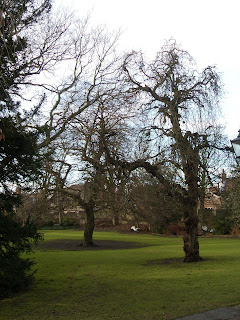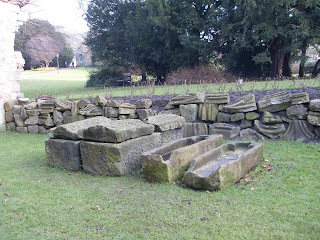Thanne greued hym a Goliardeis, a gloton of wordes
- Piers Plowman, William Langland
She saw a scholar
Ensconced by a tree
"What do you do, sir,
Come and do me!"
Come and do me!"
- From Carmina Burana, transl. David Parlett
The term goliard has been passed down to us from the late twelfth-century. It does not denote an organised body of men - such as a gild or a monastic order - but is rather an identity or claim of adherence made by the goliards themselves as followers or disciples of Golias. The figure of Golias may stem from a pseudonym belonging to an existing person of the 12th century, but most likely he is just an invention of a group of rhymester clerks or students forging what appears like a mock-myth of origin. We can see some similarities between the goliards and the much later invention of Christian Rosenkreutz as head of the rosicrucian movement, with the exception that the rosicrucians never existed.
The goliards were students and clerics, poets and vagrants, using ecclesiastical and scriptural conventions in their humorous and strongly satirical poetry, especially mocking the clergy. They were considered blasphemous and other clerics launched verbal attacks against them well into the 13th century. In modern times the goliardic poetry was long considered "unmedieval", an anachronism not belonging to the Middle Ages. I for my part think the Goliards must be understood from the intellectual atmosphere of the 12th century.
In many respects the 12th century was a very vibrant age, particularly so in the intellectual world. Simultaneously with the Gregorian reform, Europe received many new impulses from the world beyond Western Christendom. This not only shows that the boundaries were permeable, but also that there was an interest in and a willingness to accept ideas and books from abroad. The four major exchange zones were Spain, Antioch, Sicily and Byzantium. From these areas numerous books were brought into Europe and translated from Greek and Arabic, and thus enhancing the intellectual spectrum of the 11th and the 12th centuries.
From the Arabic and Greek spheres Europe became acquainted with many old texts of Galen, Aristotle, Ptolemy and the like, but the 12th century was not merely an age of rediscovery and thinking, but rethinking and discovery. Along with the Greek texts came books on Arab astrology, medicine, alchemy and so forth, spurring intellectual debate and making its impact on the scholarly agenda. In this sense the 12th century was an age of both the traditional and the modern, and this became manifest in the willingness to confront custom. Particularly this became evident in the debate on the liberal arts; several scholars attacked the definition of the arts, such as William of Conches' assault on Priscian's grammar. New arts emerged - like ars dictaminis, the art of letter-writing - and Geoffrey of Vinsauf's treatise titled Poetria Nova from the turn of the century clearly indicates a consciousness of the new mood and the new age.
This is the first part of the backdrop against which one must consider the goliardi. The second part is the emergence of universities and their struggle for increased independence.
The universities were a product of the twelfth century, growing out of the urban cathedral schools into a new kind of institution. At the turn of the 11th century education of the laity was mainly a matter for monastic schools, although there never was a clerical monopoly on teaching, and although the liberal arts were a goal for the monasteries few of them had the resources to give proper education in all seven. The origin of the cathedral school harkened back to the reorganisation during the Carolingian era, and as the number of men of learning increased throughout the 11th and the 12th centuries there naturally developed organisations - or gilds - of scholars at intellectual centres, which in many cases grew into universities. Not all cathedral schools reached that far, however. With the increase of students and masters the episcopal control of learning probably gained in the course of the Gregorian reform was reduced, a trend that continued throughout the century.
Prior to the establishment of the universities students had sojourned at intellectual centres for the sake of a particular master famed for his teaching, as was the case of John of Salisbury who spent 12 peripatetic years becoming an erudite man. With the universities education became more organised; a curriculum was set down, fixed periods of study and degrees were established. However, despite the fact that the bishops lost some control over the matters of learning at the universities, Paris, for instance, became increasingly dependent on papal support and thus papal subordination.
Stephen of Tournai (1128-1203) once lamented that theology was debated too vigorously, causing holy matters such as the indivisibility of the Trinity to be subject to blasphemy and scandal. This would be a non-surprising consequence in a milieu of multiple scholars and new impulses, but it equally less surprising caused the universities to be subject to stricter papal control.
New ideas and new impulses also spurred new conflicts and this intellectual evolution was marked by a number of them. Naturally there occurred disagreements within the various disciplines, but skirmishes also took place on a greater level. One of these was between scholars, represented by Peter Abelard, and mystics, represented by Bernard of Clairvaux, where Bernard admonished Abelard saying that the divine matters was not suitable for philosophers. Another conflict was between those scholars adhering to the traditional allegorical reading of the Bible and those preferring the literal interpretation. A third was between universities and the papacy, which was a disagreement over control and interference.
It is against this backdrop we must understand the emergence of the goliardi. In an expanding intellectual milieu marked by the aforementioned conflicts it is no surprise that students frustrated with papal intervention or the anti-intellectualism of certain clerics antagonised them and made them subjects for harsh satire, criticising the critics. It is not therefore to be claimed that the goliardi did not point out actual problems of their age and opposed actual abuse by clerics, but they ought to be considered as a product of certain conflicts which strip them from any objectivity in the matters at hand. Considering this the goliardic poets become just as Medieval as anything in the High Middle Ages, establishing them as a product of their time rather than the perceived anachronism believed in later ages, for they can be understood solely when seeing them against the intellectual milieu of the 12th century.
Illustration from Carmina Burana, a collection of Goliardic poetry from the High Middle Ages.

















































